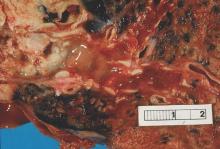Tumor lymphocytic infiltration (TLI), categorized as intense or nonintense, was an independent prognostic indicator for survival in non–small cell lung cancer (NSCLC).
Patients with intense TLI had significantly longer overall survival (OS) and disease-free survival (DFS), compared with patients who had nonintense TLI. In the validation data set, 5-year OS for patients with intense TLI was 85% (95% confidence interval, 70-92), compared with 58% (95% CI, 54-62) for patients with nonintense TLI (P = .002). Five-year DFS was 79% (95% CI, 65-88) for intense and 50% (95% CI, 47-54) for nonintense TLI (P = .001).
The retrospective study evaluated data from four randomized clinical trials, separated into a discovery set of 783 patient samples and a validation set of 763 patient samples. The LACE-Bio (Lung Adjuvant Cisplatin Evaluation Biomarker) collaborative group trials examined the benefit of platinum-based adjuvant chemotherapy in NSCLC. The median follow-up for the discovery and validation sets were 4.8 and 6.0 years, respectively.
Differences in outcomes according to TLI were significant in both discovery and validation data sets. In the discovery set, hazard ratios for OS and DFS were 0.56 (95% CI, 0.39-0.81; P = .002) and 0.59 (95% CI, 0.42-0.83; P = .002), respectively. In the validation set, OS and DFS hazard ratios were 0.45 (95% CI, 0.23-0.85; P = .01) and 0.44 (95% CI, 0.24-0.78; P = .005), respectively. Differences in risk reductions between the two data sets may be a result of differences in trial populations.
“The results raise the question about whether lymphocytic infiltration should be considered a stratification factor in trials that test immunotherapy or immunomodulation. Therefore, as suggested recently for CD8 density level in NSCLC, which predicted survival independently of all other variables and within each pathologic stage, intense lymphocytic infiltration could be a good candidate marker for establishing a TNM immunoscore,” wrote Dr. Elisabeth Brambilla of Institut Albert Bonniot–Institut National de la Santé et de la Recherche Médicale, La Tronche, France, and her colleagues (J Clin Onc. 2016 Feb. 1. doi: 10.1200/JCO.2015.63.0970).
In contrast to results from breast cancer studies, TLI did not predict differential survival benefit from adjuvant chemotherapy in NSCLC.
The intensity of TLI on hematoxylin- and eosin-stained representative sections was first assigned into one of four categories (minimal, mild, moderate, and intense). The first three categories subsequently were collapsed into one to form a binary scoring system of intense and nonintense infiltration.


